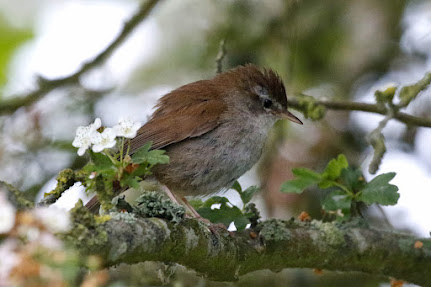Sunday 12th May 2024
RSPB Minsmere
This was another good
turnout from our members who braved the early start and the long coach trip to
enjoy seven and a half hours bird watching at this flagship RSPB reserve on the
east coast of Suffolk. Their reward was
a massive species count of 80 with some stunning birds. The weather was fine throughout with sunshine
and a gentle breeze.
Our first port of call was the artificial sand
cliffs just outside the café to look at the breeding sand martins.
- We got a huge shock as there
were no sand martins around at all – all we experienced was an eerie
silence in an area which was previously always noisy with the frantic sound of
birds toing and froing in the nesting area!
Apparently,
this year they had chosen to breed a few miles further north, on the cliffs at
Dunwich Heath. Let’s hope this was just
a blip and that they return next year.
- All was not
lost however as we saw plenty of sand martins flying over the scrapes while we
moved around the reserve and they were by far the most ubiquitous of the
hirundines.
- Everyone enjoyed seeing a lesser whitethroat
singing out from the top of a nearby bush. Alan Loweth managed to get this
lovely picture using his mobile phone!
Courtesy of Alan Loweth
- Some waders of course change their appearance
drastically in summer. like this grey
plover
and this turnstone
Courtesy of Martin Jeffree
and, better still, this red knot, my bird of
the day! What a contrast with the knot
still in winter plumage!
Courtesy of Martin Jeffree
- The rarest waders we saw were 2 Temminck’s stints
from the West Hide. Alas, they were so
far away from us it was difficult to make the ID with any degree of
certainty. Fortunately, a local
birder/volunteer who had been following them all day and had seen them when
they were closer, pointed them out to us.
- We saw 3 tern species, 2 distant little
terns were seen on the scrape but not photographed
- As we walked along the western path our eyes were directed to the skies
where the hobbies finally put in an appearance with at least 6 on show.
By far the most popular areas of the reserve are the Bittern Hide and the
Island Mere Hide and they were jammed full with visitors when we got there.
- We still had time to wait for the bitterns to appear.
.
A small group of us decided to try and find
the stone curlews at the north-west area of the reserve on the heath by
the exit road towards Westleton.
- Our luck was in again as Phil soon spotted 2 of them in the field
adjacent to the track we were on. What a
great view we had of these pre-historic looking birds with their distinctive
yellow eye-ring.
Courtesy of Phil Aylen
- As a final gesture, a nightingale sang for us from the bushes just
a few metres form the coach as we assembled for the departure.
A
superb trip!
2024 species count=175


























